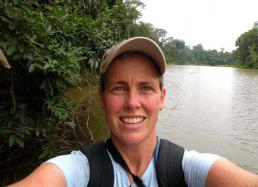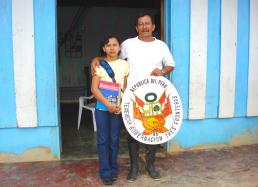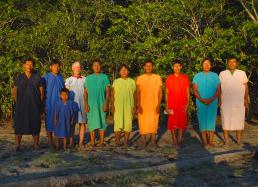Collaborations
A Message from Dr. Corine Vriesendorp:
The inventory would not have been possible without the concerted efforts of our scientific team (a fantastic group from the U.S., Peru, and Ecuador), the deep knowledge and strong organizational skills of local indigenous communities, as well as the support of dedicated staff in non-governmental and governmental agencies, regional military personnel, and collaborating local and national institutions. These broader teams ensured that the scientific data collected communicated directly with the policy makers and major stakeholders in the region. To all, we offer our sincere thanks along with a huge sigh of relief that together we were able to carry out the long and complicated field itinerary and the subsequent in-country presentations and preparations for the written report.
Specifically, I'd like to acknowledge the following individuals and organizations:
The inventory would not have been a success without permission and support for work in the region from several indigenous organizations. These organizations will be central players in the efforts to translate the recommendations of this report into action: Organización Indígena Secoya del Perú (OISPE), Federación Indígena de la Nacionalidad Cofan del Ecuador (FEINCE), Organización Kichwaruna del Alto Napo (ORKIWAN), and the Organización Regional de Pueblos Indigenas del Oriente (ORPIO).
In Ecuador, our main collaborators and counterparts were the Cofan Survival Fund (Fundación para la Sobreviviencia del Cofan), the Cofan indigenous people, and their leader, Randy Borman, who first suggested an inventory of the region years ago. The Cofan community of Zábalo (on the Aguarico River) was the hub of the biological inventory of the first three sites.
In Peru, our main collaborator was the National Institute for Natural Resources (Instituto Nacional de Recursos Naturales, INRENA). In addition, we collaborated with several regional universities and museums, including the Universidad Nacional Mayor San Marcos in Lima, the Universidad Nacional de la Amazonia Peruana in Iquitos, and the Museo Ecuatoriano de Ciencias Naturales in Quito.
The Airo Pai (Secoya) communities of Bellavista, San Martín, Santa Rita, Nuevo Belén (on the Yubineto River), Mashunta (Angusilla River), Zambelín (Yaricaya River), Guajoya (Santa María River), and Puerto Estrella (Lagartococha River) helped us immensely with field logistics and provided valuable information to the biological and social teams.
The biological and social teams are grateful for the help and information shared by the Murui (Huitoto) community of Santa Teresita (on the Peneya River), and by the Naporuna (Kichwa) communities of Miraflores (Putumayo River), Torres Causana, Santa María de Angotero (Napo River), and Zancudo (Aguarico River).
We also thank members of the mestizo communities of Tres Fronteras (Putumayo River) and Angoteros (Napo River), who played important roles in the work of the biological and social teams.
Other national and regional organizations provided crucial help and advice, including the Ministerio del Ambiente (L. Altamirano, G. Montoya) and Herbario Nacional (QCNE) in Ecuador; and in Peru, the Asociación Interétnica de Desarrollo de la Selva Peruana (AIDESEP), Ministerio de Relaciones Exteriores-Cancillería del Perú (Pablo Cisneros), Instituto Nacional de Recursos Naturales (INRENA)-Lima (Jorge Ugaz, Miryan García, Jorge Lozada, Carmen Jaimes), Instituto de Investigaciones de la Amazonía Peruana (IIAP)-Iquitos, Hotel Doral Inn-Iquitos, Vicariato Apostólico de Iquitos, Kantu Tours-Lima, Hotel Señorial-Lima, and Alas del Oriente-Iquitos.
Personnel at regional military bases gave us permission to travel in sometimes difficult border areas, offered useful advice, and showed a surprising degree of interest in our work. These individuals were stationed at several military bases in Peru: Cabo Pantoja (Napo River), Güeppí (Putumayo River), Aguas Negras (Lagartococha River); and in Ecuador: Zancudo (Aguarico River), Lagartococha, Patria (Lagartococha River), and Panupali (Güeppí River). Pilots of the Fuerza Aérea del Perú (FAP)-Iquitos skillfully extracted the field teams and their mountain of gear at the close of the inventory.
As usual, our advance teams overcame many challenges. Guillermo Knell and Italo Mesones, leaders of the two advance field teams, were responsible for the establishment of inventory camps 3, 4, and 5, and their respective trail systems. Through great effort, and with time against them, they were able to complete all of their tasks before the inventory began. Their efforts allowed the biological inventory team to be successful in its work, and we are grateful to them. Other Peruvian friends and colleagues at the Centro de Conservación, Investigación y Manejo de Áreas Naturales (CIMA) provided excellent logistical support in the field, in Iquitos, and in Lima during our trip.
Likewise, several individuals were stellar in the organization and management of logistics in Ecuador. Roberto Aguinda orchestrated the supply of food and additional equipment for the advance team in camps 1 and 2, as well as for all five camps during the inventory proper. Freddy Espinosa and his wife, Maria Luisa López, ensured coordination of efforts from their base in Quito. Sadie Siviter, Hugo Lucitante, Mateo Espinosa, Juan Carlos González, Carlos Menéndez, Víctor Andrango, and Lorena Sánchez provided fast and efficent logistical aid from the offices of the Fundación Sobrevivencia Cofan, in Quito, before, during, and after the inventory; Elena Arroba did the same from the FSC office in Lago Agrio. John Lucitante drew the graphic of the giant river otter that we printed on T-shirts for participants.
Special thanks go to our cooks.
Other friends and colleagues provided help or insights with specific, critical elements of the inventory. For this, we offer our thanks to Coronel PNP Dario “Apache” Hurtado Cárdenas, Luis Narvaez, César Larraín Tafur, Carlos Carrera, Aldo Villanueva, Carolina de la Rosa, Maria Luisa Belaunde, Pepe Álvarez, Cindy Mesones, Daniel Schuur, Rodolfo Cruz Miñán, Milagritos Reátegui, and Yolanda Guerra.
The herpetological team thanks Karl-Hainz Jungfer for his valuable help in determining the species of Osteocephalus; William Lamar for his useful comments about the diversity of the herpetofauna of Iquitos; Walter Schargel for his determination of the species of Atractus; Diego F. Cisneros-Heredia, for sharing his knowledge of the Tiputini region; Lily O. Rodríguez, who generously shared her information about her collections made at Aguas Negras, Peru, in 1994; L. Cecilia Tobar and Paúl Meza-Ramos, who from Quito made available literature held in the Museo Ecuatoriano de Ciencias Naturales (MECN); and Carlos Carrera for his constant help and support in the care of collections at MECN.
For their invaluable guidance and help in the exporting process for the plant collections, the botany team is profoundly grateful to the Ministerio del Ambiente (MAE).
We also thank Marcela Galvis, Adriana Rojas Suárez, and Rafael Sánchez (Parques Nacionales Naturales de Colombia) for supplying up-to-date information on P.N.N. La Paya.
From our home base in Chicago, we received invaluable help from these individuals: Jonathan Markel prepared excellent maps using digitalized satellite images, both for the advance team and the later biological inventory team. Dan Brinkmeier quickly produced visual materials extremely useful for in-country presentations, and developed graphics for extension efforts in local communities, all of which explained the results of our inventory. Tyana Wachter was critically important for the inventory, from Chicago to Lima, Iquitos, and Quito. She, together with Chicago-based Rob McMillan and Brandy Pawlak, wove their magic to make problems disappear as they arose. Brandy and Tyana also carefully proofread the report. We thank Wilber H. Gantz for a critical upgrade of our GPS-navigation system. Finally, Jim Costello and staff of Costello Communications continued to help us streamline and perfect the editing and production of printed and on-line reports, and showed remarkable patience in the process.
Funds for this inventory were provided by The Hamill Family Foundation and The Field Museum.
The Negaunee Foundation generously funds the EXPEDITIONS at the field museum





